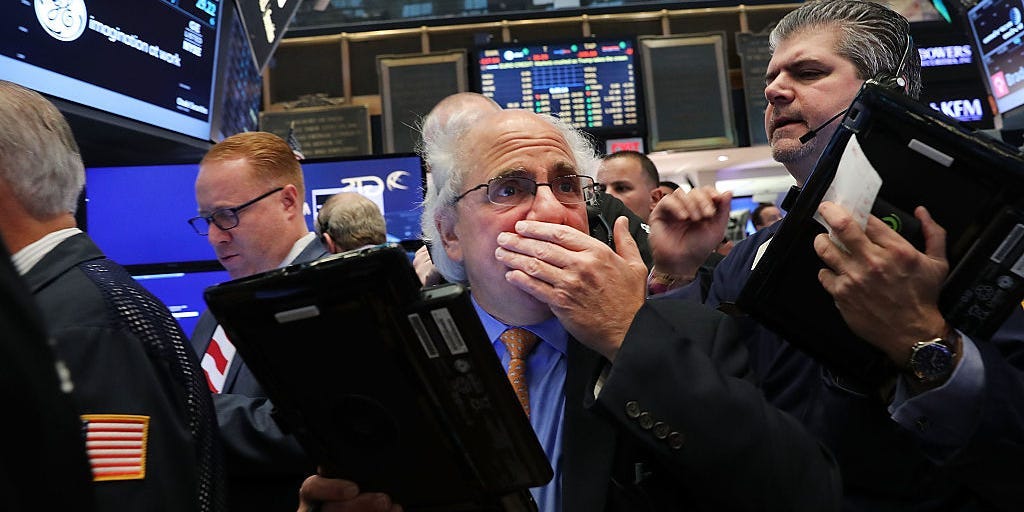The war in Ukraine has sent oil prices soaring and crushed hopes of a strong global economic rebound. Oil hit its highest level in more than a decade this week, and wheat, metals and natural gas have all surged. That’s sparked fears about “stagflation”, a toxic combination of red-hot inflation and low or negative growth. Loading Something is loading.
Russia’s invasion of Ukraine and the tough sanctions that have followed have sent oil prices soaring to their highest levels in more than a decade. They’ve also crushed hopes of a strong global rebound from the coronavirus crisis.
The conflict has got Wall Street analysts talking about investors’ worst nightmare: stagflation.
What exactly is stagflation?
Stagflation is a mixture of high inflation and a stagnant economy.
It was the defining economic term of the 1970s, a decade in which the US entered a crushing recession , but inflation nonetheless soared above 12%.
The stagflation of the ’70s shocked economists. Up until then, the consensus was that inflation would cool when the economy slowed, because fewer people would be wanting to buy goods and services.
Now, it has the potential to shock investors.
Why are markets worried about stagflation?
Russia’s war in Ukraine has lit a fire under global commodities prices, thanks to the importance of both countries as providers of raw materials.
Despite the US and its allies steering clear of directly hitting Russia’s energy sector with penalties, Western buyers have been “self-sanctioning”, and shunning the country’s oil.
WTI crude, the US benchmark oil price, surged to a 14-year high of over $116 a barrel Thursday, while Brent crude hit a 12-year high above $119. They were still trading around those levels Friday.
But it’s not just oil. Wheat (Ukraine is a major supplier), industrial metals, and natural gas have all rocketed higher. The S&P global commodities index had shot up around 20% over the last month as of Friday.
The price rises have sparked fears that inflation in the US — which is already running at a 40-year high — and elsewhere could surge even more.
Investors and economists worry that central banks could be forced to hike interest rates harder and faster to bring prices under control, slowing economies. They’re also nervous that people will spend less as items become dearer.
Read more: Macro strategists at a $900 billion asset manager break down how war in Ukraine and the related energy market turmoil could derail the Fed’s monetary policy plans — and reveal which countries’ stock markets are best placed to ride out the storm
“There are stagflation scenarios in front of us,” European Central Bank official Mario Centeno warned in a speech Wednesday, Reuters reported.
The Atlanta Federal Reserve on March 1 predicted that US growth was likely to be roughly flat in the first quarter, following a rapid 7% annualized growth rate in the final quarter of 2021.
Federal Reserve Chair Jerome Powell said Wednesday that the US economy still looked strong, but that the likely effects of the Ukraine conflict “remain highly uncertain.”
Why is stagflation so bad for markets?
Investors hate uncertainty, but stagflation clouds the outlook. Traders and strategists are left guessing when and by how much central banks will hike interest rates to bring prices back under control, and whether it’ll further whack growth.
If the economy slows, companies’ profits will naturally suffer as people spend less, even as inflation adds to their costs.
A portfolio of global stocks, bonds and real estate could end up losing 13% if the war in Ukraine drags on, according to analysts at MSCI.
The analysts, led by Thomas Verbraken, said US stocks could fall around 20% from pre-invasion levels, if the Fed has to hike rates sharply even as confidence is slumping.
Can it be avoided?
Many investors have said worries about the economy are overblown, particularly in the US, where growth is expected to stay strong in 2022.
“It’s on my radar screen, but no, I’m not worried about it,” Brian Rauscher, head of global portfolio strategy at Fundstrat, told Insider.
“We think this is going to be kind of a challenging early part of the year, and then inflation is likely to peak.”
Rauscher said investors should remain cautious, however. “We don’t have to make any large bets here in this first part of the year when we’re volatile.”
